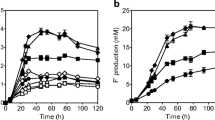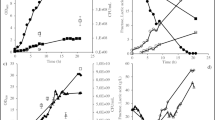Abstract
Research on the impact of Maillard reaction products (MRPs) on microorganisms has been reported in the literature for the last 60 years. In the current study, the impact of an MRP-rich medium on the growth of three strains of Escherichia coli was measured by comparing two classic methods for studying the growth of bacteria (plate counting and optical density at 600 nm) and by tracing MRP utilisation. Early stage and advanced MRPs in the culture media were assessed by quantifying furosine and N ε-carboxymethyllysine (CML) levels, respectively, using chromatographic methods. These measures were performed prior to and during bacterial growth to estimate the potential use of these MRPs by Escherichia coli CIP 54.8. Glucose and lysine, the two MRP precursors used in the MRP-rich medium, were also quantified by chromatographic means. Compared to control media, increased lag phases and decreased growth rates were observed in the MRP-rich medium for two out of the three Escherichia coli strains tested. In contrast, one strain isolated from the faeces of a piglet fed on a MRP-rich diet was not influenced by the presence of MRPs in the medium. Overall, CML as well as the products obtained by the thermal degradation of glucose and lysine, regardless of the Maillard reaction, did not affect the growth of the three strains tested. In addition, no degradation of fructoselysine or CML was found in the presence of Escherichia coli CIP 54.8.



Similar content being viewed by others
References
AFSSA (2007) Avis de l’agence française de sécurité des aliments concernant les références applicables aux denrées alimentaires en tant que critères indicateurs d’hygiène des procédés Saisine no 2007-SA-0174. ANSES. http://www.anses.fr/Documents/MIC2006sa0215.pdf 20 p. Accessed on 1 Dec 2012
Ames JM, Wynne A, Hofmann A, Plos S, Gibson GR (1999) The effect of a model melanoidin mixture on faecal bacterial populations in vitro. Br J Nutr 82(6):489–495
Ames J, Hinton D, Crabbe K, Tuohu K, Gibson G (2005) Glycated proteins: analysis and implications of dietary forms for human health and disease. In: Euro food chem XIII macromolecules and their degradation products in food—physiological, analytical and technological aspects, Hamburg
Arribas B, Suarez-Pereira E, Ortiz Mellet C, Garcia Fernandez JM, Buttersack C, Rodriguez-Cabezas ME, Garrido-Mesa N, Bailon E, Guerra-Hernandez E, Zarzuelo A, Galvez J (2010) Di-d-fructose dianhydride-enriched caramels: effect on colon microbiota, inflammation, and tissue damage in trinitrobenzenesulfonic acid-induced colitic rats. J Agric Food Chem 58(10):6476–6484. doi:10.1021/jf100513j
Baranyi JZ, Roberts TA (1994) A dynamic approach to predicting bacterial growth in food. Int J Food Microbiol 23(3–4):277–294. doi:10.1016/0168-1605(94)90157-0
Barer MR (1997) Viable but non-culturable and dormant bacteria: time to resolve an oxymoron and a misnomer? J Med Microbiol 46(8):629–631
Bhattacharjee MK, Sugawara K, Ayandeji OT (2009) Microwave sterilization of growth medium alleviates inhibition of Aggregatibacter actinomycetemcomitans by Maillard reaction products. J Microbiol Methods 78(2):227–230. doi:10.1016/j.mimet.2009.06.004
Chalova VI, Hernández-Hernández O, Muthaiyan A, Sirsat SA, Natesan S, Sanz ML, Moreno FJ, O’Bryan CA, Crandall PG, Ricke SC (2011) Growth and transcriptional response of Salmonella Typhimurium LT2 to glucose-lysine-based Maillard reaction products generated under low water activity conditions. Food Res Int 45(2):1044–1053. doi:10.1016/j.foodres.2011.06.044
Cohen-Or I, Katz C, Ron EZ (2011) AGEs secreted by bacteria are involved in the inflammatory response. PLoS ONE 6(3):e17974. doi:10.1371/journal.pone.0017974
Corzo-Martinez M, Avila M, Moreno FJ, Requena T, Villamiel M (2011) Effect of milk protein glycation and gastrointestinal digestion on the growth of bifidobacteria and lactic acid bacteria. Int J Food Microbiol 153(3):420–427. doi:10.1016/j.ijfoodmicro.2011.12.006
Delgado-Andrade C, Tessier FJ, Niquet-Leridon C, Seiquer I, Pilar Navarro M (2011) Study of the urinary and faecal excretion of Nepsilon-carboxymethyllysine in young human volunteers. Amino Acids 43(2):595–602. doi:10.1007/s00726-011-1107-8
Einarsson H, Snygg BG, Eriksson C (1983) Inhibition of bacterial growth by Maillard reaction products. J Agric Food Chem 31:1043–1047
Faist V, Erbersdobler HF (2001) Metabolic transit and in vivo effects of melanoidins and precursor compounds deriving from the Maillard reaction. Ann Nutr Metab 45(1):1–12. doi:10.1159/000046699
Field MF, Lichstein HC (1957) Factors affecting the growth of propionibacteria. J Bacteriol 73(1):96–99
Foster EM (1952) The effect of heat on milk as a culture medium for lactic acid bacteria. J Dairy Sci 35(12):988–997. doi:10.3168/jds.S0022-0302(52)93785-5
Hachisuka Y, Asano N, Kato N, Okajima M, Kitaori M, Kuno T (1955) Studies on spore germination. I. Effect of nitrogen sources on spore germination. J Bacteriol 69(4):399–406
Henle T (2007) Dietary advanced glycation end products-a risk to human health? A call for an interdisciplinary debate. Mol Nutr Food Res 51(9):1075–1078. doi:10.1002/mnfr.200700067
Jemmali M (1969) Influence of the Maillard reaction products on some bacteria of the intestinal flora. J Appl Bacteriol 32(2):151–155
Kim KW, Lee SB (2003) Inhibitory effect of Maillard reaction products on growth of the aerobic marine hyperthermophilic archaeon Aeropyrum pernix. Appl Environ Microbiol 69(7):4325–4328
Kostyukovsky V, Marounek M (1995) Maillard reaction products as a substrate in vitro rumen fermentation. Anim Feed Sci Technol 55(3–4):201–206. doi:10.1016/0377-8401(95)00804-V
Lanciotti R, Anese M, Sinigaglia M, Severini C, Massini R (1999) Effects of heated glucose-fructose-glutamic acid solutions on the growth of Bacillus stearothermophilus. LWT Food Sci Technol 32(4):223–230. doi:10.1006/fstl.1998.0534
Lin HL, Lin CC, Lin YJ, Lin HC, Shih CM, Chen CR, Huang RN, Kuo TC (2010) Revisiting with a relative-density calibration approach the determination of growth rates of microorganisms by use of optical density data from liquid cultures. Appl Environ Microbiol 76(5):1683–1685. doi:10.1128/AEM.00824-09
Manley-Harris M, Richards GN (1996) Di-d-fructose dianhydrides and related oligomers from thermal treatments of inulin and sucrose. Carbohydr Res 287(2):183–202. doi:10.1016/0008-6215(96)00071-7
Mastrocola D, Munari M (2000) Progress of the Maillard reaction and antioxidant action of Maillard reaction products in preheated model systems during storage. J Agric Food Chem 48(8):3555–3559
Mester L, Szabados L, Mester M (1983) Maillard reactions of therapeutic interest. In: The Maillard reaction in foods and nutrition, vol 215. ACS Symposium Series. American Chemical Society, pp 451–463. doi:10.1021/bk-1983-0215.ch024
Mironova R, Niwa T, Hayashi H, Dimitrova R, Ivanov I (2001) Evidence for non-enzymatic glycosylation in Escherichia coli. Mol Microbiol 39(4):1061–1068
Moisés Laparra J, Corzo-Martinez M, Villamiel M, Javier Moreno F, Sanz Y (2011) Maillard-type glycoconjugates from dairy proteins inhibit adhesion of Escherichia coli to mucin. Food Chem 129(4):1435–1443. doi:10.1016/j.foodchem.2011.05.102
Monnier VM (2005) Bacterial enzymes that can deglycate glucose- and fructose-modified lysine. Biochem J 392(Pt 2):e1–e3. doi:10.1042/BJ20051625
Niquet-Léridon C, Tessier FJ (2011) Quantification of Nε-carboxymethyl-lysine in selected chocolate-flavoured drink mixes using high-performance liquid chromatography-linear ion trap tandem mass spectrometry. Food Chem 126(2):655–663. doi:10.1016/j.foodchem.2010.10.111
Prescott L, Harley J, Klin D (1995) Microbiologie,5th edn. DeBoeck-Université
Rabbani N, Thornalley PJ (2010) Glycation research in amino acids: a place to call home. Amino Acids 42(4):1087–1096. doi:10.1007/s00726-010-0782-1
Rurian-Henares JA, Morales FJ (2008) Antimicrobial activity of melanoidins against Escherichia coli is mediated by a membrane-damage mechanism. J Agric Food Chem 56(7):2357–2362. doi:10.1021/jf073300
Schleicher E, Wieland OH (1981) Specific quantitation by HPLC of protein (lysine) bound glucose in human serum albumin and other glycosylated proteins. J Clin Chem Clin Biochem 19(2):81–87
Sheikh-Zeinoddin M, Perehinec TM, Hill SE, Rees CED (2000) Maillard reaction causes suppression of virulence gene expression in Listeria monocytogenes. Int J Food Microbiol 61(1):41–49. doi:10.1016/S0168-1605(00)00371-8
Stecchini ML, Giaveedoni P, Sarais I, Lerici CR (1993) Effect of Maillard reaction on the growth of selected food-poisoning micro-organisms. Lett Appl Microbiol 13:93–96
Swiatecka D, Narbad A, Ridgway KP, Kostyra H (2011) The study on the impact of glycated pea proteins on human intestinal bacteria. Int J Food Microbiol 145(1):267–272. doi:10.1016/j.ijfoodmicro.2011.01.002
Tessier FJ (2009) The Maillard reaction in the human body. The main discoveries and factors that affect glycation. Pathol Biol 58(3):214–219. doi:10.1016/j.patbio.2009.09.014
Tessier FJ, Niquet C (2007) The metabolic, nutritional and toxicological consequences of ingested dietary Maillard reaction products: a literature review. J Soc Biol 201(2):199–207
Tuohy KM, Hinton DJ, Davies SJ, Crabbe MJ, Gibson GR, Ames JM (2006) Metabolism of Maillard reaction products by the human gut microbiota-implications for health. Mol Nutr Food Res 50(9):847–857. doi:10.1002/mnfr.200500126
Viswanathan L, Sarma PS (1957) A growth inhibitor of L. bulgaricus o9. Nature 180(4598):1370–1371
Wiame E, Delpierre G, Collard F, Van Schaftingen E (2002) Identification of a pathway for the utilization of the Amadori product fructoselysine in Escherichia coli. J Biol Chem 277(45):42523–42529. doi:10.1074/jbc.M200863200
Wiame E, Lamosa P, Santos H, Van Schaftingen E (2005) Identification of glucoselysine-6-phosphate deglycase, an enzyme involved in the metabolism of the fructation product glucoselysine. Biochem J 392(Pt 2):263–269. doi:10.1042/BJ20051183
Acknowledgments
Authors would like to thank Véronique Rame and Daniel Chua for their technical support.
Conflict of interest
The authors declare that they have no conflict of interest.
Author information
Authors and Affiliations
Corresponding author
Rights and permissions
About this article
Cite this article
Helou, C., Marier, D., Jacolot, P. et al. Microorganisms and Maillard reaction products: a review of the literature and recent findings. Amino Acids 46, 267–277 (2014). https://doi.org/10.1007/s00726-013-1496-y
Received:
Accepted:
Published:
Issue Date:
DOI: https://doi.org/10.1007/s00726-013-1496-y




